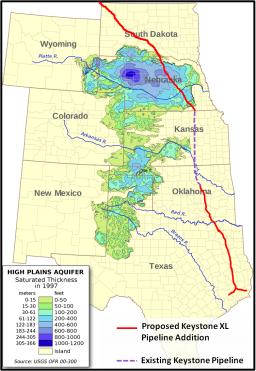TransCanada Begins Injecting Oil Into Keystone XL Southern Half. Environmental Consequences?
Exact Start Date Unconfirmed

Keystone XL’s southern half is one step closer to opening for business. TransCanada announced that “on Saturday, December 7, 2013, the company began to inject oil into the Gulf Coast Project pipeline as it moves closer to the start of commercial service.”
The Sierra Club’s legal challenge to stop the pipeline was recently denied by the U.S. Court of Appeals for the Tenth Circuit, so the southern half, battled over for years between the industry and environmentalists, will soon become a reality.

According to a statement provided to DeSmog by TransCanada,
“Over the coming weeks, TransCanada will inject about three million of [sic] barrels of oil into the system, beginning in Cushing, Oklahoma and moving down to the company’s facilities in the Houston refining area.”
In mid-January, up to 700,000 barrels per day of Alberta’s tar sands diluted bitumen (dilbit) could begin flowing through the 485-mile southern half of TransCanada’s pipeline, known as the Gulf Coast Project. Running from Cushing, Oklahoma to Port Arthur, Texas, the southern half of the pipeline was approved by both a U.S. Army Corps of Engineers Nationwide Permit 12 and an Executive Order from President Barack Obama in March 2012.
Bloomberg, The Canadian Press and The Oklahoman each reported that the Gulf Coast Project pipeline is now being injected with oil. Line fill is the last key step before a pipeline can begin operations.
“There are many moving parts to this process — completion of construction, testing, regulatory approvals, line fill and then the transition to operations,” TransCanada spokesman Shawn Howard told DeSmog. “Line fill has to take place first, then once final testing and certifications are completed, the line can then go into commercial service.”
Residents living along the length of the southern half will have no clue about the rest of the start-up process, as TransCanada says it won’t provide any more information until the line is already running. “For commercial and contractual reasons, the next update we will provide will be after the line has gone into commercial service,” the company announced.
When DeSmog asked whether the company is currently injecting conventional oil or diluted bitumen sourced from the Canadian tar sands, TransCanada’s Howard replied:
“Many people like to try and categorize the blend, etc., however we are injecting oil into the pipeline. As you’ve likely seen me quoted before, oil is oil and this pipeline is designed to handle both light and heavy blends of oil, in accordance with all U.S. regulatory standards.
I am not able to provide you the specific blend or breakdown as we are not permitted (by our customers) from disclosing that information to the media. There are very strict confidentiality clauses in the commercial contracts we enter into with our customers, and that precludes us from providing that. The reason is that if we are providing information about a specific blend, when it is in our system, etc. – that has the potential to identify who our customers may be or allow others to take financial positions in the market and profit from that information when others do not have access to the same information. This has much farther reaching impacts for the financial markets (and ultimately all of us).”

